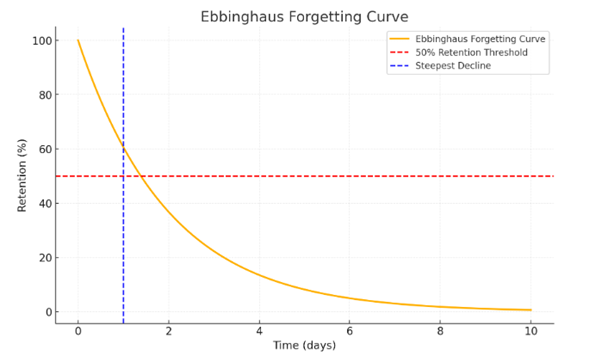Boost Your Memory Retention
How Spaced Repetition Can Help You Remember More Effectively

As self-developers we are always trying to learn new information and more importantly perhaps we seek always to retain it.
I’ll be the first to admit that it isn’t easy but stress not - I’ve got your back.
There is an approach which will pay huge dividends so consider experimenting and who knows, your powers of knowledge retention may skyrocket.
This needs to be a slightly long and slightly technical post which will look at two concepts then map them together for the memory boost we seek.
The two elements of our solution are The Ebbinghaus Forgetting Curve and Spaced Repetition.
The Ebbinghaus Forgetting Curve
The Ebbinghaus Forgetting Curve, developed by German psychologist Hermann Ebbinghaus in the late 19th century, illustrates the decline of memory retention over time.
Based on his experiments, Ebbinghaus discovered that information is quickly forgotten unless actively reviewed.
His curve demonstrates that memory loss occurs exponentially, meaning we forget most of the information within the first few days of learning unless steps are taken to reinforce it.
Key insights from the Ebbinghaus Forgetting Curve:
- Immediate Forgetting: Without reinforcement, we forget approximately 50% of newly learned material within an hour.
- Retention Drops Rapidly: After 24 hours, retention decreases to about 30%, and it continues to diminish further.
- Repetition Improves Retention: Repeatedly revisiting material slows the rate of forgetting and solidifies memory.
This rapid decline occurs due to how the brain prioritises information. Items deemed unimportant or unused are discarded to conserve mental resources.

Spaced Repetition
Spaced repetition is a powerful learning technique designed to counteract the forgetting curve by strategically timing reviews of material to optimise retention.
It involves revisiting information at increasing intervals, allowing memory to stabilise and strengthen over time.
This approach works because it leverages two principles:
- The Spacing Effect: Revisiting material after intervals enhances learning more effectively than massed, crammed study sessions.
- Active Recall: Actively having to retrieve partially forgotten information strengthens neural pathways and boosts memory.
You may be familiar with a language learning app called Duolingo. Amongst other things Duolingo makes great use of spaced repetition learning principles. The periodic use of “Flashcards” is another well-known example of this approach.
How the Two Work Effectively Together
The synergy between the Ebbinghaus Forgetting Curve and spaced repetition lies in their complementary mechanisms:
- The forgetting curve predicts when memory retention is likely to decline.
- Spaced repetition provides a method to counteract that decline, reinforcing knowledge just before it is forgotten.
By understanding the points of steepest memory decline, spaced repetition schedules can be customised to optimise learning. For example:
- First Review: 1 to 2 days after the initial learning session (#1 on diagram)
- Second Review: 4 days later (#2 on diagram)
- Third Review: 6 days later (#3 on diagram)
- Subsequent Reviews: At progressively longer intervals (e.g., two weeks, one month).

The diagram is for illustration purposes only but the idea is that even though retention levels still drop, they drop less each time and they even out at a higher retention percentage than previously. After a while you will have created much more durable memories of that information. Moreover, they will be memories which can be recalled much more easily.
With repeated spaced recall activity these memories can effectively become permanent - I can never forget my times tables for instance.
Some Practical Applications
Suppose you're learning a foreign vocabulary. Using spaced repetition, you could:
- Learn 10 new words today.
- Review them the next day, focusing on the ones you struggled with.
- Review again three days later, then one week later.
- Gradually extend the intervals between reviews as recall improves.
If you're studying for an exam, spaced repetition could look like this:
- Day 1: Review lecture notes.
- Day 2: Test yourself on key concepts.
- Day 5: Solve related practice questions.
- Day 10: Summarise and recall the material without looking at notes. This method prevents cramming and ensures long-term understanding.
Organisational learning programmes can benefit from using spaced repetition in employee training situations to ensure retention of critical procedures. For instance, new hires might complete initial safety training, followed by periodic refreshers every month, and finally biannual workshops.
Over to you
We self-developers (autodidacts) should always be super-keen to experiment.
If you’re not taking advantage of some (or all) of the learning hacks which scientists can tell us about, then you’re missing some very powerful opportunities to assist you on your self-development journey.
Go ahead and give this approach a try.
References
- Cepeda, N. J., et al. (2006). Spacing Effects in Learning: A Temporal Ridgeline of Optimal Retention. Psychological Science, 17(3), 267–272.
- Rohrer, D., & Pashler, H. (2007). Increasing Retention Without Increasing Study Time. Current Directions in Psychological Science, 16(4), 183–186.
- Ebbinghaus, H. (1885). Memory: A Contribution to Experimental Psychology.
Hopefully that's offered you some food for thought.
Have a good one and I'll see you next time.
All the very best to you and yours
Andrew D Pope.










